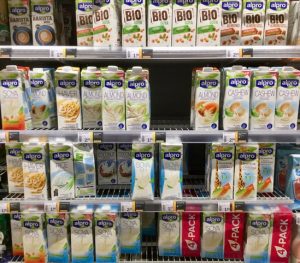At my local Dutch supermarket yesterday, I stared in utter confusion at the shelf of soya drinks, faced with explosion of possible choices & combinations. And I’m not alone. In supermarkets everywhere, it seems to be soya madness. As the ‘plant-based’ category has grown rapidly, offering attractive alternatives to dairy-based food and drinks, a profusion of products has popped up across categories (drinks, yoghurt, ice cream etc.). The category is in need of effective range architecture.
My local supermarket offered 14 different product references just for leading brand Alpro. And this is only part of the story. In total Alpro’s range has 32 drinks; less than half were on my supermarket shelf! The complex range navigation was based on five different variables:
- Ingredient? (Soya, Almond, Coconut, Cashew, Oat, Hazelnut, Rice etc.)
- Single ingredient or multiple?
- Organic or not?
- Roasted or Unroasted?
- Sweetened or Unsweetened?
Now, brand architecture is supposed to make it easy and intuitive for consumers to navigate a product range and find what they want, as we posted on recently. But this didn’t seem to be happening here.
So, I poured myself a nice glass of chilled almond milk (unroasted – I wanted roasted but picked the wrong pack) and wrote down a few things to remember when expending or re-visiting your range architecture:

1. Keep it simple, even when it’s tough.
Effective range architecture is tricky. We often say that it’s like a jigsaw puzzle with too many pieces.
In an exploding category like plant-based drinks, brands are throwing as many options as they can at the consumer, to ‘see what sticks’. The risk with this approach is too much choice, leading to ‘consumer paralysis’. As psychologist Barry Schwartz explains, excessive numbers of inputs (e.g. product options) leads to angst, indecision and ultimately lowered satisfaction, with both the purchase process and the products themselves (1).
Effective range architecture should be about making it easy for people to find what they want, not create a picture-perfect range on the brand manager’s office shelf. This is especially true if you are playing the role of category captain.
Mini workout #1: make some tough decisions on the key products that should be in your range, and those that shouldn’t. We work with teams to do this based on two key variables: i size of prize, and ii. ability to win.
2. Focus on the core, before adding more
Too often, we see great pack innovation or product upgrades being kidnapped by new sub-brands, instead of being used to upgrade the core range to make it more relevant. This not only undermines the core range, it creates complexity and risks fragmenting the brand.
Mini workout #2: start by ensuring that your core range has what it takes to attract recruit and keep consumers. If there is a new upgrade on the table, consider as a first option using this to upgrade the core, making what is strong even stronger. Only if the stretch from the core is significant (e.g. owing to a higher price point) should a range extension be used.
3. Follow the shopper
Ideally, effective range navigation uses data including shopper ‘decision trees’ to create a range architecture that makes consumer choice easy. Shopping with consumers also helps bring to life the decision process, as we found on a global brand architecture project for Whiskas.
We sent each team member on an accompanied ‘shopping safari’, to see how consumers were making choices in real life. This personal experience brought the data to life and made it way more persuasive, in addition to throwing up new insights. For example, consumers were way more promiscuous than the team expected, often shopping across brands, based on one lead criteria (e.g. ” I want chicken, whatever the brand”).
Mini workout #3:Think about your customer decision process: Which reference is your recruitment product, and so should be an ‘anchor’ product in the range? What are the first, second and third criteria used to make a purchase decision (e.g. Pack size? Flavor? Benfit?), to guide the key variables used to structure the range.
4. Make execution ‘simply better’
To ensure execution works with, not against, the navigation principles of your brand or category, don’t get distracted by design elements and aesthetics; focus on clarity and communication. And keep in mind what your range will look like in the real world. For example, when working on range architecture with the Whiskas team, we reminded them that the average store would have not have the full range of 27 products on shelf, but more like five.
To aid navigation, keep things simple. On Whiskas, we desired this approach ‘Call a cat a cat’. For example, the team got rid of terms like ‘senior’ and called the senior range 7+ instead to be more direct. There is little space on a cat food pack, so the new approach was to avoid wasting space on unnecessary descriptors.
Mini work out #4: have a look at your ‘real range’, the one that is most likely to be put on shelves or real stores. Does it look like a proper range? Is it still easy to understand and navigate?
5. Don’t lose sight of your brand vision
Your range architecture should fit (or at minimum not clash) with your brand vision. For example, if your brand is all about care and gentleness, you don’t want to use “% fat” as the ‘red thread’ to structure your range architecture.
In the case of Whiskas, choosing life stage as the central navigation axe for the range made sense. It was novel for a mainstream brand, allowed for many future range developments, helped bring clarity to the range and reflected broad expertise from kitten to senior cats.
Think also about your future vision in terms of new product innovation and the “new babies” that might be added to the range. This way, you can check that the architecture is ‘future proof’.
Mini work out #5: review your range architecture against your brand vision. How does it help bring to life the brand idea? And is it flexible enough to provide a home for future products in your innovation pipeline.
In conclusion, to avoid soya madness, and create a range architecture that helps make buying easy, follow the shopper with a practical, real-life approach.
To further explore brand architecture check out this other post.
We explore brand purpose in depth on our brandgym Mastering Brand Growth program. If you’d like more info on the program, simply pop your name and email in the form below (we’ll also send you the weekly brandgym blog email and brandgym Academy news, but you can opt out at any time).
Sources:
(1) https://hbr.org/2012/05/to-keep-your-customers-keep-it-simple
